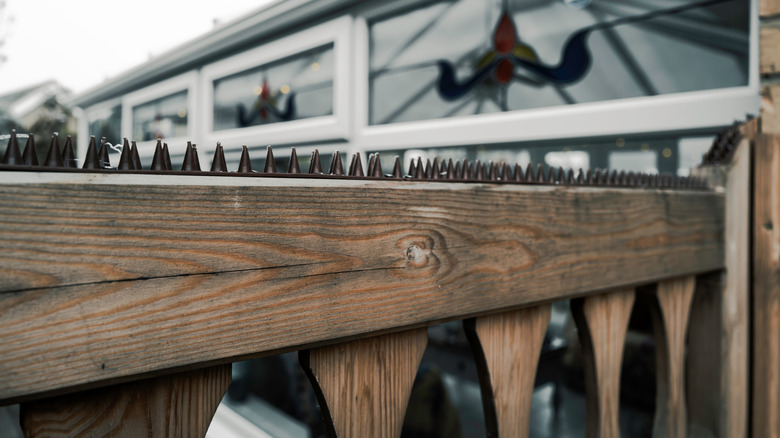The Fence Topper Solution That'll Keep Pests And Intruders Out (And Whether It's Right For You)
Fences are a great way to add extra privacy to your yard while keeping pests, strangers, and other intrusions out. By itself, however, a fence isn't enough to stop everything from getting into your yard. If you're extra concerned about intruders and pests, you can install anti-climb spikes on top of your fence as a deterrent. Before doing so, you need to double check that it's legal where you live.
Made from plastic or metal, anti-climb spikes are installed at the top of your fence to serve as a physical barrier and visual deterrent. If anyone or anything tries climbing your fence, anti-climb spikes are mostly meant to make them uncomfortable. Although they may cause a little pain, real harm shouldn't be your actual goal — especially if you're trying to keep animals out. While animals like raccoons or stray cats can be annoying, there's no need to be inhumane. Besides, in some areas, devices that are clearly intended to cause harm like nails or sharp spikes are outright illegal.
Compared to other security measures, one of anti-climb spikes' main benefits is that they're easy to install. However, if you want to purchase them, these spikes should only be used on tall fences. Some manufactures recommend 6 feet as the minimum while specific municipal codes may require that your fence is at least 7-feet tall. If your fence is shorter than that, you need to look into alternative solutions. Otherwise, make sure that you purchase anti-climb spikes made from a material that can hold up well to all types of weather like polypropylene plastic or stainless steel.
Are anti-climb spikes legal?
Okay, you've decided that anti-climb spikes are right for you. You might even have them in your online cart. Before hitting "confirm", though, you need to check that they are allowed where you live. In the United States, there is no single law dictating the legality of anti-climb spikes. Generally, though, most local laws prohibit the use of barbed wire, razor wire, or sharp spikes. For more specifics, you'll need to check your state and city laws. But note that if a person or animal hurts themselves, you can potentially be held liable for injury depending on your location.
So, when installing anti-climb spikes, it's recommended to add a warning to your fence to caution people about them. This may help your case if any injuries happen. However, those warnings may not be enough to stop litigation. In addition to consulting local authorities or municipal codes, you may want to bring your homeowner's insurance into the conversation to ensure that they will actually help if someone was to sue.
Finally, you need to make sure that the fence you want to install these spikes on is actually yours. That might sound obvious but it can be tricky to determine if your fence outdates you. Plus, in the U.S., fences that are directly on the property line are generally considered to be co-owned by you and your neighbor. In those cases, you need to consult your neighbors before adding anything to your fence. If you're uncertain about fence ownership, check your property survey, deed, or contact a surveyor.
Alternatives to spikes for your fence
Anti-climb spikes might be useful for some; however, there are much simpler (and legally straightforward) methods to deter intruders and pests. For example, some creative ways to add height to your existing fence include a metal fence topper. Sometimes, all you need is a bit of extra height to keep intruders out. Not only will these decorative additions achieve that but they can also add some curb appeal to your fence.
If that doesn't catch your eye, consider installing spinning fence toppers instead. Basically, these devices roll whenever something tries climbing your fence. If your main concern is animals, these are a great, humane alternative to installing anti-climb spikes. In addition to keeping other animals out, some people install spinning fence toppers to keep their own pets in their yard. You can also look into using anti-climbing paint on the top of your fence. This thick, oily paint never really dries so it creates a slippery surface.
Lastly, you can keep animals out of your yard without modifying your fence. The exact methods vary depending on the animal that you're dealing with, but, generally, you just need to change up a few things to make your backyard less inviting. For example, an expert's humane recommendations to keep raccoons out of your yard included removing any food sources like garbage bins, compost piles, and pet dishes. Similarly, if you want to keep unwanted stray cats out of your yard, consider using a natural deterrent like citrus.


